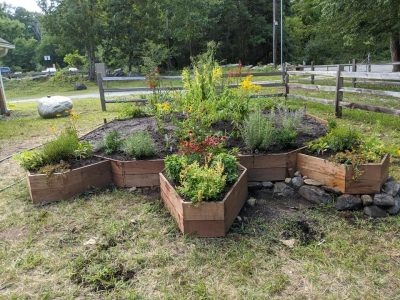Thanksgiving and Native American Heritage Month
As we prepare to celebrate the 400th anniversary of the first Thanksgiving, we may be thinking about how the Pilgrims and the Indigenous community came together in 1621.
Since November is also Native American Heritage Month, we would like to honor the indigenous peoples that once inhabited this land and are still here!

Turtle-shaped pollinator garden at Blackstone River Watershed Council
In November 1621 the “pilgrims” were celebrating the first successful harvest with the 53 remaining from the voyage to the new world.
However, this harvest may not have been successful if not for the help of Tisquantum, aka Squanto. He lived among the English settlers (they never called themselves pilgrims) in Plymouth, which originally was his village of Patuxet.
He taught them how to plant corn, beans and squash in what is known as the “three sisters garden.” There are three examples located in the Blackstone Valley. They are: Old Slater Mill National Historical Landmark in Pawtucket, Roger Williams National Memorial in Providence and most recently Hunts Mills in East Providence planted a “three sisters garden” in June with the aid of Pokanoket Tribe member, Elsie “Napauz” Upshaw. Learn More
The area in which the Blackstone River Valley sits was once part of the Plymouth Colony and earlier than that was part of territory occupied by the Pokanoket; Wampanoag or Wopanaak, “People of the Light;” Nipmuck, “freshwater people;” and the Narragansett, “people of the small point.”
We know that prior to colonial settlement and industrialization of the Blackstone Valley the Native American nations referred to the Blackstone River as”Kittacuck” an Algonquin term meaning “great tidal river” also Pawtucket is Algonquin meaning “by the falls.”
Wampanoag, Pokanoket, Nipmuck and Narragansett are still members of the Blackstone Valley Community today just as other Native American nations around New England are still here.
Why not take a moment during the Thanksgiving holiday to thank the people for whom’s land we share and acknowledge their place at the table.
See Blackstone Region Indigenous Lands (after you click the link put in your town or city)
Thanksgiving Traditions
The traditional Thanksgiving meal usually consists of turkey, stuffing, cranberry sauce, squash and of course, the green bean casserole. You may think you are celebrating as the pilgrims did.
However, there may have been squash and beans at that table, but you wouldn’t find cranberry sauce (no sugar available) or green beans in a casserole.
Most likely in addition to fowl there may have been fish and clams at the “First Thanksgiving.”
As we gather with family and friends, we may carry on some other traditions in addition to preparing and eating a turkey dinner, such as watching the Thanksgiving Day Parade and perhaps watching or playing some football.
Walking in nature after the big meal may also be a tradition for some.
A great local place for reflection and to walk off that Thanksgiving meal is at Sycamore Landing located at 100 River Road in Manville and home of the Blackstone River Watershed Council.
The watershed council have worked with Nipmuck Nation to create a meditative space that includes a pollinator garden in the shape of a turtle.
The turtle shape represents “grandmother earth.” The turtle is a revered animal spirit in many of Native American Cultures.
Many Thanksgiving blessings to you.
Please consider revisiting the Blackstone Valley in the spring and summer months to see the aforementioned gardens in bloom.
